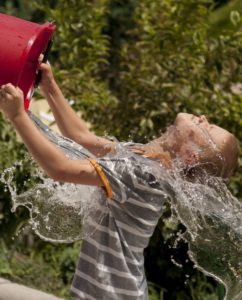 We’re in the middle of another long stint of 90+ degree days and many lawns are definitely showing signs of stress. But before you pour on more water, make sure you are not already over-watering your lawn. As many landscape experts including turf scientists at CSU will tell you, most lawn disease problems in Colorado directly result from over-watering.
We’re in the middle of another long stint of 90+ degree days and many lawns are definitely showing signs of stress. But before you pour on more water, make sure you are not already over-watering your lawn. As many landscape experts including turf scientists at CSU will tell you, most lawn disease problems in Colorado directly result from over-watering.
In a heat wave, it’s tempting to crank up the length of time the sprinkler system waters. But before you do, make sure the lawn is really telling you it needs more – not less – water. The best starting point is to push a screwdriver into the soil. If the soil is hard, that shows lack of moisture. If it drives right into the soil, there is already sufficient moisture.
Signs your lawn needs water
Our lawns really do talk back to us and that is by how they look. Brown spots that are dry in the screwdriver test tell you that spot is not getting enough water. Blueish/gray areas also indicate lack of water. If you leave footprints when you walk across the lawn, that’s another sign.
On the other hand, when the lawn is over-watered, it talks back with unsightly areas across the lawn that are often patches of disease. With over-watering, those problems will only get worse.
If you see patches that look similar to a doughnut in the lawn with circular areas of yellow or brown with a green center, this could be a sign of necrotic ring spot. Another common problem seen frequently in Colorado is ascochyta. Both of these diseases disrupt the healthy green look of a thriving lawn. And both are tied to over-watering.
Before you turn up the water in this heat wave, make sure that lack of water is really the problem:
- Check the soil to see if it is dry or moist.
- Look carefully at your lawn for possible signs of disease. If you’re not sure, consult with a pro who can diagnose disease issues.
- Check out the sprinkler system to see if some areas of the lawn are not being watered at all and fix the problems.
- Avoid the temptation to apply more water. And when you need to apply more water, use the cycle-and-soak method of short watering cycles broken up by a rest period and then another watering cycle later. This technique allows water to soak into the soil without creating wasteful run-off.
Relieve heat stress on your lawn by following these mowing practices:
- Raise the mower blade to the highest setting and cut no more than about ¼ of the total grass height off the top. When we leave the grass higher, it shades the soil to help it retain moisture.
- Sharpen the mower blade regularly. A dull blade shreds rather than cuts and grass blades that are shredded are more stressed and open to diseases than when they are cut cleanly.
- When you mow, leave the clippings on top of the lawn. This also helps retain moisture and the clippings will fertilize the lawn as they decompose.
By following these simple and sustainable steps, you will help your lawn survive the heat wave.
Courtesy of ALCC Sustainable Landscape Partner
